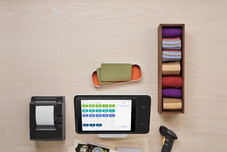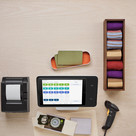Table of contents
Wrapping your head around sales taxes can be one of the more daunting aspects of running a business. So we’re excited to announce that our friends over at TaxJar, a service you can integrate with your Square account to make sales tax compliance easier, will be regularly contributing their expert tips and advice to this blog.
If you have more questions about sales tax, or just want to know more, **sign up for TaxJar’s free webinar Sales Tax for Square Merchants** on Tuesday, January 13, at 10 a.m. PT/1 p.m. ET.
If you sell products, you most likely have to deal with sales tax. And if you have to deal with sales tax, it’s even more likely that you have a sales tax due date this January.
But never fear. We’ve put together a short and sweet guide for Square merchants facing sales tax this January.
Let’s get started.
1. Determine where you have sales tax nexus
States use sales tax to pay for things like schools, roads, and public safety. So they’re very interested in ensuring that sellers collect and remit sales tax on purchases. But the only merchants that a state can require to collect sales tax within its state borders are merchants with sales tax nexus in that state.
Sales tax nexus is basically just a fancy way of saying “a significant presence” in a state. Nexus can be established due to:
- An office in the state
- A brick-and-mortar store or premises in the state
- An employee in the state
- Storing goods in a warehouse in the state
- An affiliate in the state
- Drop-shipping from a third-party provider in a state
- Temporarily doing business in a state for a limited amount of time, such as at a trade show or craft fair
If you do all your work from home or your shop, you probably only have nexus in one state. But if your business meets any of the criteria listed above in another state, you may have sales tax nexus there. Check with the state’s taxing authority now to make sure you don’t receive a fine or penalty later.
2. Register for a sales tax permit
Once you’ve determined that you have sales tax nexus in a state, your next step is to register for a sales tax permit with that state’s department of revenue (or equivalent taxing authority).
When you register for your sales tax permit, the state will tell you when and how often it wants you to file a sales tax return. This can be annually, quarterly, or monthly.
Every state is different. So if you have nexus in more than one state, you may find that you pay monthly in one state and annually in another.
3. Collect sales tax
Your next step is to begin collecting sales tax from customers. Here’s how to set up your Square Point of Sale to collect sales tax from customers.
One vital point to keep in mind is that if you have nexus in a state, then you must collect sales tax from all customers in that state. This can be confusing if you sell on multiple channels.
Here’s an example:
You live and operate your business in Tennessee but cross the state line to sell your handmade jewelry at a craft market in Virginia on weekends. Now you have sales tax nexus in both Tennessee and Virginia and must collect sales tax from buyers in both states. But say you also sell on Etsy. Now that you have sales tax nexus in two states, you must also make sure that you’re collecting sales tax from buyers in both Tennessee and Virginia through Etsy.
4. Report how much sales tax you’ve collected
So you’ve determined where you need to charge sales tax, registered for a sales tax permit, and started collecting sales tax from your buyers.
Now, as your sales tax deadline approaches, you must determine how much sales tax you’ve collected from your buyers and prepare to report it to the state.
This involves figuring out much you collected in sales tax from buyers in every state on all platforms on which you sell. If you only sell through Square and only collect sales tax in one state, this can be fairly simple. But if you sell on more than one channel, or have multistate nexus, your life gets very complicated very fast.
And most states won’t make it easy to prepare a sales tax return. In a perfect world, you would determine how much sales tax you’d collected, remit it to the state, and be done. But a majority of states also require you to break down the sales tax you’ve collected by county, city, and special taxing district. Worst-case scenario: You’re going over every transaction, trying to compare it to your state’s tax tables to figure out how to categorize it on your sales tax return. This gets even harder if you sell on multiple platforms.
Fortunately, you can remove the complications of sales tax reporting with automated solutions — like linking your Square account to TaxJar. But no matter what method you choose to report your sales tax collected, your next step is the same.
5. File sales tax
Now for the moment of truth when you remit the sales tax you’ve collected back to the state.
You can file sales tax online at your state’s department of revenue website. There are a few best practices for sales tax filing to keep in mind:
- File on time. Not only does this prevent a late fee, but also at least 24 states will actually give you a sales tax discount for filing early or on time. Don’t leave free money on the table.
- Don’t forget “zero returns.” Many states want to hear from anyone with an active sales tax permit even if you didn’t collect a penny in sales tax. So don’t forget to file a zero sales tax return with your state by your deadline, even if you don’t have any collected sales tax to remit.
And with that, you’ve tackled sales tax. Congratulations!
About TaxJar
Sales tax is complex. That’s why we created TaxJar — to handle the burden of sales tax while you get back to running your business. TaxJar pulls in sales tax collected from all the channels where you sell, compiles your data into return-ready reports, and will even AutoFile your sales tax returns for you in 26 states (and counting). Sign up for a 30-day TaxJar free trial today and put a lid on sales tax. And check out Square App Marketplace for more information on how to link your Square account to TaxJar’s tools.
![]()












